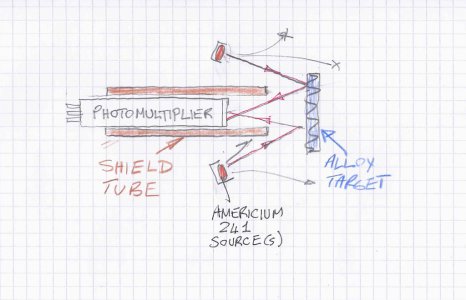@rwm Rob speculating about Chinese lightweight neutrons

is thankfully not it, but messing with what we have at this level, is getting close to that region of what happens with matter and energy being known (to me) as "wierd sh*t". We cannot really know the photon is even there until the current comes into existence, and if it encounters diffraction edges and gaps, we maybe end up doing our fractured version of the double slit experiment?
Looking to why the "low" count.
Starting from the diode, we have the X100-7 data sheet.
The probability of a 60keV incoming X-ray doing something other than passing straight through is shown as near 3%.
We can't know what X-ray source was used to test the diode, but we keep in mind that the graph is about probability in a 10mmx10mm area. To get the 0.03 number, the tester must have known the flux onto that area. However many glows we can make coming out of stuff the Am241 is pounding on (every now and then), and also direct from the Am241 speck of oxide, they are going to be going all over the place.
By our mechanical surrounds, we have it that most of "all over the place" means encountering shielding, where it wastes itself, except for some extremely rare photon that might eventually make it to the other end of the galaxy. We can only work with those that are kind enough to make it to our detector, and some get lucky enough to encounter some diode stuff. Those will be 3% of photons in a 100mm^
2 area fraction of a sphere area 4π*r^2. I thought r=50mm, or about a couple of inches, if we were trying to get something to happen from direct 60keV. One could, I suppose, put up to maybe four Am241 sources right down onto the diode
Putting aside, for the present, all the glow X-rays it might splatter when it encounters metals, consider first the direct 60keV stuff we hope to see. In my sketch from post #35, the Am241 is denied any opportunity to have it's 60keV photons make it to the diode, but suppose we change things to allow it.
Calculating the pulses
Since 1978, the average amount of Am241 Oxide in a smoke detector changed from 3 microCuries to 1 microCurie. This is equivalent to 37,000 decays per second. Those be numbers are for smoke detectors in USA.
According to Wikipedia, 85% of those decays are 5.486MeV alpha, 13% is 5.443MeV of (something), and 5.338MeV for the remaining 2%.
Umm.. that adds up to 100%. Where are the 59.5409keV Gammas? Where are the 13.9keV, 17.8keV and 26.4keV other bits?
Out of the 37,00 decays, is it going to be "
hardly any"??
37,000 per second is 37kBq.
PDF jackpot!
I am still reading it, and unfortunately, I have to go to attend something else.
From just a quick look, this guy's germanium detector was 10mm diameter.
His source was 3.7E9 Bq. That is 100,000 times stronger than the smoke detector.
His source was a whole ring, instead of six spots.
His detector area was
78.5mm^2. The X100-7 diode is
100mm^2
His collection time was 2000 seconds, ie. three minutes more than half an hour.

He was getting about 19 counts per second direct from the Am241
While looking at Zinc, 49.1KeV, counting at 3 or 4 per second, he was getting about 3 per second from Am241.
While looking at Molybdenum, he was getting 4 to 5 counts per second from Am241.
We do
know that the pocket-geiger was used to do this trick. Something must be wrong!
Please help me check, and reconcile the numbers, because at this rate, with
6 smoke detectors, we would have to wait
13.8 hours to see one count originating from the Am241?? This is very roughly speaking. Detector area, strike probability, aperture fraction etc. not included yet.
There is a gross error somewhere. We should be able to predict quite closely the counts we see. We should be able to tell if the smoke detector is doing anything at all, We should see other pulse events also, like some background we can see, and stop with shielding.
Maybe his germanium detector, when this was done, has a much lower detect efficiency than a X100-7 diode??
We have to look for more papers. Maybe there is a typo about the Bequerels from Amersham International source.



